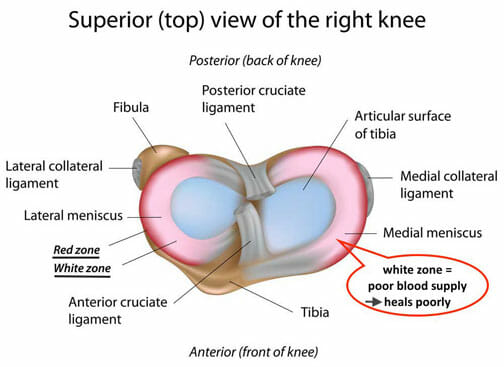CellULAR Treatment FOR meniscus tears IS BECOMING INCREASINGLY ROUTINE.
The meniscus is the knee’s shock absorbers, protecting cartilage from the trauma of jumping, running, lifting and weight bearing. Sometimes with lifting and/or a quick change of direction, the meniscus can tear, resulting in knee pain. 90% of the meniscus, called the White Zone, has a poor blood supply and does not do well with surgical repair.
Only the outer 10% of the meniscus, called the Red Zone, has a good blood supply and can be surgically sutured and repaired. However, any surgical trimming of the meniscus will lead to early knee arthritis or wearing down of the cartilage and joint breakdown.
All of our minimally invasive outpatient treatments have the goal of regenerating cells, alleviating pain, improving function and ultimately reducing or eliminating our patients’ suffering. We provide the latest cutting-edge and low-risk alternatives to invasive surgeries, allowing our patients to avoid those associated risks and long recovery times.



Surgery for meniscus tears is only suitable in a very small number of cases:
1. Small tears in the outer 10% of the meniscus known as the red zone.
2. Any knee injury with knee joint locking.
If you have knee pain due to a meniscus tear (without knee locking), cellular therapy may be an excellent and best alternative to helping your body repair a torn meniscus.
Other alternatives for the treatment of meniscus tears all have significant problems:
1. Surgical trimming of the meniscus (meniscectomy) leads to early knee joint arthritis and joint breakdown.
2. Steroid injections have been shown to be ineffective in treating long term knee pain and those patients who have had steroid joint injections do much worse after joint replacement .
3. Gel injections may provide temporary knee pain relief, but regenerative medicine procedures have been shown to have better results than gel injections.
1 Effect of intra-articular Triamcinolone vs Saline on knee cartilage volume and pain in patients with knee osteoarthritis: A randomized clinical trial; McAlindon TE, LaValley MP, Harvey WF, Price LL, Driban JB, Zhang M1 Ward RJ.; JAMA. 2017 May 16;317(19):1967-1975. doi: 10.1001/jama.2017.5283. Link to Article
2 Intrarticular hip injection and early revision surgery following total hip arthroplasty: a retrospective cohort study; Ravi B1, Escott BG, Wasserstein D, Croxford R, Hollands S, Paterson JM, Kreder HJ, Hawker GA.; Arthritis Rheumatol. 2015 Jan;67(1):162-8. doi: 10.1002/art.38886. Link to Article
3 Intra-articular injection of two different doses of autologous bone marrow mesenchymal stem cells versus hyaluronic acid in the treatment of knee osteoarthritis: multicenter randomized controlled clinical trial (phase I/II); Lamo-Espinosa JM, Mora G, Blanco JF, Granero-Moltó F, Nuñez-Córdoba JM,Et Al., J Transl Med. 2016 Aug 26;14(1):246. doi: 10.1186/s12967-016-0998-2. Link to article
There are many research studies show that cellular therapy and platelet rich plasma injections may provide excellent relief from joint and musculoskeletal pain and ongoing inflammation.
IMPORTANT! This information is for educational purposes only and is NOT intended to replace the care or advice given by your physician. Boston Applied Biologics is not offering regenerative cell therapy or other regenerative therapies as a cure for any condition, disease, or injury. No statements or implied treatments on this website have been evaluated or approved by the FDA. This website contains no medical advice. All statements and opinions provided by this website are provided for educational and informational purposes only and we do not diagnose or treat via this website or via telephone. We do not claim that any applications, or potential applications, using autologous regenerative cells and other regenerative cells are approved by the FDA, or are even effective. We do not claim that these treatments work for any listed nor unlisted condition, intended or implied. Always seek the advice of your physician or other qualified health provider before starting any new treatment or with any questions you may have regarding a medical condition. For more information see our Medical Disclaimer.
Copyright © 2025 Boston Applied Biologics, LLC. All Rights Reserved.

How Orthobiologic Therapy can relieve your joint, muscle and tendon pain without surgery so that you can get back to enjoying your life*
We are committed to your privacy. Boston Applied Biologics uses the information you provide us to contact you about relevant content, products, and services. By providing us with your information you are consenting to the collection and use of your information in accordance with our Terms of Service and Privacy Policy. You may unsubscribe from these communications at any time.